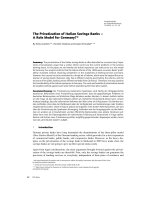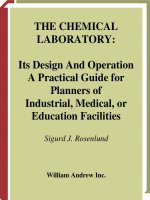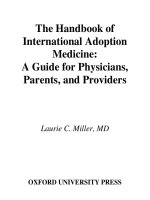the handbook of patient safety compliance a practical guide for
Bạn đang xem bản rút gọn của tài liệu. Xem và tải ngay bản đầy đủ của tài liệu tại đây (2.91 MB, 289 trang )
TeAM
YYePG
Digitally signed by TeAM YYePG
DN: cn=TeAM YYePG, c=US,
o=TeAM YYePG, ou=TeAM
YYePG, email=
Reason: I attest to the accuracy
and integrity of this document
Date: 2005.07.07 15:05:57 +08'00'
rozo_14409_ffirs.qxd 2/4/05 1:42 PM Page i
rozo_14409_ffirs.qxd 2/4/05 1:42 PM Page ii
THE HANDBOOK OF PATIENT
SAFETY COMPLIANCE
rozo_14409_ffirs.qxd 2/4/05 1:42 PM Page iii
rozo_14409_ffirs.qxd 2/4/05 1:42 PM Page iv
THE HANDBOOK
OF PATIENT SAFETY
COMPLIANCE
A Practical Guide for Health
Care Organizations
Fay A. Rozovsky and James R. Woods Jr., Editors
Foreword by Maree Bellamy
Y
rozo_14409_ffirs.qxd 2/4/05 1:42 PM Page v
Copyright © 2005 by Quality Medical Communications, LLC. All rights reserved.
Published by Jossey-Bass
A Wiley Imprint
989 Market Street, San Francisco, CA 94103-1741 www.josseybass.com
No part of this publication may be reproduced, stored in a retrieval system, or transmitted in any form
or by any means, electronic, mechanical, photocopying, recording, scanning, or otherwise, except as per-
mitted under Section 107 or 108 of the 1976 United States Copyright Act, without either the prior writ-
ten permission of the Publisher, or authorization through payment of the appropriate per-copy fee to
the Copyright Clearance Center, Inc., 222 Rosewood Drive, Danvers, MA 01923, 978-750-8400,
should be addressed to the Permissions Department, John Wiley & Sons, Inc., 111 River Street,
Hoboken, NJ 07030, 201-748-6011, fax 201-748-6008, e-mail:
Jossey-Bass books and products are available through most bookstores. To contact Jossey-Bass directly
call our Customer Care Department within the U.S. at 800-956-7739, outside the U.S. at 317-572-
399386 or fax 317-572-4002.
Jossey-Bass also publishes its books in a variety of electronic formats. Some content that appears in print
may not be available in electronic books.
Library of Congress Cataloging-in-Publication Data
The handbook of patient safety compliance : a practical guide for
health care organizations / Fay A. Rozovsky and James R.
Woods Jr., editors. — 1st ed.
p. ; cm.
Includes bibliographical references and index.
ISBN 0-7879-6510-3 (alk. paper)
1. Medical errors. I. Rozovsky, F. A. (Fay Adrienne), 1950- .
II. Woods, James R., 1943- .
[DNLM: 1. Medical Errors—prevention & control. 2. Guideline
Adherence—organization & administration. 3. Medical Errors—legislation &
jurisprudence. 4. Safety Management—organization & administration.
WB 100 H2363 2005]
R729.8.H36 2005
610—dc22 2004019606
Printed in the United States of America
FIRST EDITION
HB Printing 10987654321
rozo_14409_ffirs.qxd 2/4/05 1:42 PM Page vi
fax 978-646-8700, or on the web at www.copyright.com. Requests to the Publisher for permission
CONTENTS
Figures, Tables, and Exhibits x
Foreword xii
Maree Bellamy
The Editors xv
The Contributors xvii
1 Patient Safety: Crossing the Chasm from Legal and Regulatory
Compliance 1
Fay A. Rozovsky
Terms That Define Patient Safety • The Legal and Regulatory Influences Constraining
Patient Safety: Evidentiary Protection • The Legal Concepts of Standards of Care and
Patient Safety
2 Patient Safety Laws and Regulations 16
Ronni P. Solomon
Mandatory Reporting Systems • Anatomy of a Patient Safety Law: Compliance
Tips • Federal Patient Safety Legislation Initiatives • Medical Device
Reporting • Clinical Trials and Adverse-Event Reporting • Patient Safety
Goals and Standards • The Quality Assessment and Performance Improvement
Rule • Smallpox Vaccine Adverse-Event Reporting • Conclusion
vii
rozo_14409_ftoc.qxd 2/4/05 1:41 PM Page vii
3 Medical Error Reduction Initiatives Among Accreditation
and Standard-Setting Organizations 34
Fay A. Rozovsky
JCAHO Patient Safety Initiatives • Patient Safety in Other Accreditation
Standards • The Leapfrog Group and the NQF as Standard-Setting
Organizations • Environment of Care Safety • ISO and Six Sigma
• Clinical Practice Guidelines • The Legal and Regulatory Consequences
of Private Sector Patient Safety Initiatives • Conclusion
4 Failure Modes and Effects Analysis: The Risks and the Rewards
in Health Care 45
Robert J. Latino
Traditional FMEA Roots • Applying Traditional FMEA to Health Care • FMEA
and Consequential Thinking • Conclusion
5 Medication Error Reduction: Voluntary and Regulatory Oversight 64
David M. Benjamin, John P. Santell
Medication Error Reduction in the Institutional Setting • Medication Error Reduction in
the Outpatient Setting • Conclusion: The Imperative for Federal Legislation
6 Benchmarking: Evidence-Based Outcome Information
and Standards of Care 96
Peter J. Pronovost, Fay A. Rozovsky
Benchmarking for Patient Safety: The Use of Evidence-Based Outcome Data • How
Payors Use Benchmark Data • How Benchmark Data Become the Standard
of Care • How Consumers Use Benchmark Data • Conclusion: Using Benchmark
Data to Achieve Patient Safety Compliance
7 Creation and Preservation of Reports, Data, and Device
Evidence in Medical Error Situations 104
Jane C. McConnell, Susan Durbin Kinter
Incident Reporting Process Overview • Proactive Steps to Identify Risk
Areas • Proactive Steps to Manage an Adverse Event • Reporting Incidents,
Adverse Events, and Medical Errors • Conclusion
8 Claims Management Risks in Patient Safety Events 124
Pamela L. Popp
The Ripple Effect of a Patient Safety Event: Malpractice, Regulatory Scrutiny, and Potential
Fraud and Abuse Litigation • Managing Legal Counsel with Different Needs and Types
of Expertise • Managing the Needs of Internal Information Users • Dealing with
Whistle-Blower Situations in Patient Safety Events • Dealing with Complex Legal Risk
Exposure and Coordinated Defense Strategies • Effects of Disclosure on Claims
Strategies and Litigation • Conclusion
viii Contents
rozo_14409_ftoc.qxd 2/4/05 1:41 PM Page viii
9 Full Disclosure 140
James R. Woods Jr.
Where Does the Education Begin? • The Art of Describing Risk • Applying These
Lessons About Risk to Obtaining Informed Consent • Rules About Disclosure
• Does Full Disclosure Work? • Disclosure Strategies • Dealing with Fear
• Conclusion
10 Patient Safety in Human Research 160
Rodney K. Adams
Creating a Patient Safety Environment for Clinical Trials • Responding to Adverse
Events • Using Data and Safety Monitoring Boards • Conclusion
11 Medical Error Reporting: Maintaining Confidentiality
in the Face of Litigation 183
Frederick Robinson, Lara E. Parkin
Evidentiary Protections at the State Level • Evidentiary Protections
at the Federal Level • Conclusion
12 Managing Patient Safety Compliance with Health
Professionals 219
Mark A. Kadzielski, Christina W. Giles
Employment and Disciplinary Issues • The Credentialing Process as a Patient
Safety Tool • The Difference Between Corrective Action and Blame • Conclusion
13 Planning for the Future 235
Fay A. Rozovsky, James R. Woods Jr.
Lessons from the Field • Conclusion: The Future Depends on Leadership
Index 243
Contents ix
rozo_14409_ftoc.qxd 2/4/05 1:41 PM Page ix
FIGURES, TABLES, AND EXHIBITS
Figures
4.1 Aircraft Subsystem Diagram 47
4.2 Typical FMEA Hazard Scoring Matrix 50
4.3 Significant Few Chart 51
4.4 LEAP New Analysis Wizard 54
4.5 New Analysis Wizard (Step 3) 55
4.6 New Analysis Wizard (Step 4) 55
4.7 Process Flow Diagram 57
4.8 Opportunity Analysis Worksheet 57
4.9 Significant Few Events 58
4.10 Significant Few Chart 59
4.11 LEAP Report 59
5.1 USP Medication Safety Initiative Model 69
5.2 Schematic of Medication Use Process in the Institutional Setting 70
5.3 Top Ten Causes of Error 77
x
rozo_14409_ftoc.qxd 2/4/05 1:41 PM Page x
Tables
4.1 Traditional FMEA Sample 47
4.2 FMEA Line Item Sample 49
5.1 Potentially Dangerous Abbreviations 72
5.2 Types of Error Associated with Computer Entry 78
5.3 Product Groups Causing Patient Harm Most Commonly
Reported to MEDMARX 83
5.4 Types of Medication Errors Triggering Claims in 1998 84
8.1 Managing Patient Safety Event Issues: Sample Chart 126
9.1 Risk Quantified in Relation to an Individual Living in a Community 144
9.2 Obstetric and Gynecologic Risks Compared with General
Life Risks 146
11.1 States with a Freedom of Information (or Equivalent) Act 192
11.2 Physician-Patient Privilege by State, November 30, 2001 198
11.3 Areas to Analyze in State Peer Review Statutes 202
Exhibits
5.1 2004 JCAHO National Patient Safety Goals 66
5.2 NCC MERP Error Category Index for Severity Levels
and Outcomes 68
Figures, Tables, and Exhibits xi
rozo_14409_ftoc.qxd 2/4/05 1:41 PM Page xi
FOREWORD
Patient safety is making the transition from infancy and is entering a tumultuous
adolescence, with all the resultant challenges.
Ensuring patient safety is the first critical step in improving quality of care. At all
levels, health care workers make decisions every day involving patient safety. Pa-
tient safety is about protecting patients from incurring harm while they are re-
ceiving health care. It is an international issue. Although safe care has always been
a priority, in recent times we have seen a growing realization of how unsafe care
affects all the key stakeholder groups in the health care sector. Recognition and
open acknowledgement have generated lively discussion as well as a search for
solutions to the problem of unsafe care.
This book provides helpful perspectives on the evolution of patient safety, and
suggestions for future activities geared to lessening the risk of harm. As discussed
in this volume, several national studies, conducted in various countries, have iden-
tified unacceptable levels of adverse patient events, leading to the establishment
of national and local strategies aimed at reducing the incidence of such events.
Indeed, throughout the world new trends are emerging, including steps taken
by organizations to appoint individuals with patient safety responsibilities, and
the specific dedication of funds to patient safety projects and research. Many work-
shops and conferences have been held, and more are on the horizon. Standards
for patient safety have been set by national groups and more are in the process
of being set, and in some locations such standards are already an integral part of
health care accreditation programs.
xii
rozo_14409_flast.qxd 2/4/05 1:41 PM Page xii
Accompanying this activity is a growing awareness of the importance of
effective governance and risk management dedicated to the provision of safe health
care services. In some settings the emphasis is on clinical risk management and
clinical governance. In others it is on enterprise-wide or integrated risk manage-
ment and health care governance strategies. As discussed throughout this book,
national and international frameworks have been established. Examples also
illustrate how risk management, patient safety, and quality improvement are
intrinsically linked, rather than functioning as separate activities.
Many organizations find it difficult to strategize beyond the identification of
error, risks, and adverse outcomes. It is essential that the right systems, protocols,
standards, and incentives be in place to address the issues that are identified. This
book provides a practical understanding of why patient safety is everyone’s
responsibility. It provides a framework for developing a patient safety program,
effectively examining the adverse events that do occur, and ensuring that appro-
priate corrective and preventive actions are reviewed for effectiveness.
When patient safety is managed properly, it requires rigorous, forward think-
ing and encourages an organization to manage proactively rather than reactively.
It requires a thorough understanding and appreciation of clinical and other
processes in the health care organization, including knowledge of key business op-
erations and the various standards and legislative requirements that have to be
met. Patient safety must be managed continuously. The material provided in this
book offers insight into a variety of patient safety tools and techniques and guid-
ance for implementing these tools and techniques to manage patient safety in a
consistent and systematic way. The underlying principles are generic, but each or-
ganization’s unique environment determines which of these tools and techniques
are likely to yield the greatest results in the local setting.
Although health care is a high-risk and complex industry, until recently it was
lagging behind other industries that experience similar consumer safety expecta-
tions. We still have much more to learn from those groups about how to create an
effective culture of safety, but the quest has begun. We now also have good in-
formation available from our own sector. The contributors to this book present re-
sources and examples from health care as well as other industries to assist health
care organizations to develop and implement patient safety programs successfully.
Some of the most eminent patient safety specialists in the world are contributors
to this volume. They have provided enormous depth and diversity of expertise to
the wider health care community and to the development of innovative patient
safety concepts.
This book also recognizes the impact of legislative and regulatory initiatives
that have helped to shape contemporary patient safety efforts in the United States.
Foreword xiii
rozo_14409_flast.qxd 2/4/05 1:41 PM Page xiii
Equally apparent in some of the chapters is the need for legislative change, es-
pecially with regard to the use of patient safety and quality data in litigation in-
volving health care professionals.
Going forward, the goal is to create a culture of safety across the continuum
of care, supported by continuous improvement initiatives and effective governance
and risk management strategies. Known already are many of the important in-
gredients in the recipe for patient safety. We know that the right culture can de-
velop only where there is strong leadership from senior managers and boards of
governance. These components must be accompanied by effective clinician in-
volvement, using techniques that capture the enthusiasm of those who deliver care.
And each of these elements must unite within the boundaries set by local medicole-
gal and regulatory conditions. A cohesive national strategy is imperative if we are
to succeed in increasing patient safety. This book draws together important
information and case studies that exemplify such initiatives, in the hope of stim-
ulating practical interventions to further patient safety.
January 2005
Maree Bellamy
Australia
Note
Epigraph: J. DeRosier, E. Stalhandske, J. P. Bagian, and T. Nudell, “Using Healthcare Failure
Modes and Effects Analysis: The VA National Center for Patient Safety’s Prospective
Risk Analysis System,” Joint Commission Journal on Quality Improvement, 2002, 27(5), 248–267.
xiv Foreword
rozo_14409_flast.qxd 2/4/05 1:41 PM Page xiv
xv
THE EDITORS
Fay A. Rozovsky has over twenty-five years of experience as a health care risk
management consultant and attorney. She has lectured extensively and authored
or coauthored over five hundred articles and several books including Consent to
Treatment: A Practical Guide; Clinical Trials and Human Research (with Rodney Adams);
and What Do I Say? Communicating Intended or Unanticipated Outcomes in Obstetrics (with
James R. Woods Jr.). Her expertise in consent law has been recognized by several
courts, including the U.S. Supreme Court in the Cruzan decision and the high-
est courts in Hawaii, Kentucky, West Virginia, and several other states. A grad-
uate of Providence College, she received a JD degree from Boston College Law
School and an MPH degree from the Harvard School of Public Health. She is
an adjunct associate professor of Medical Humanities at the University of
Rochester School of Medicine and Dentistry and an affiliate associate professor
in the Department of Legal Medicine at the Medical College of Virginia. She
is admitted to the practice of law in Florida and Massachusetts. A Distinguished
Fellow of the American Society for Healthcare Risk Management, she is also a
past president of the society. In 1998, she was awarded ASHRM’s Distinguished
Service Award, the highest honor bestowed on a member of ASHRM. Currently,
she is the chair of the Professional Technical Advisory Committee for Hospitals
of the Joint Commission on Accreditation of Healthcare Organizations.
rozo_14409_flast.qxd 2/4/05 1:41 PM Page xv
James R. Woods Jr. is the Henry A. Thiede Professor and chair of the
Department of Obstetrics and Gynecology at the University of Rochester School
of Medicine, Rochester, New York. He completed medical school at the Bowman
Gray School of Medicine, his residency in obstetrics and gynecology at Tripler
Army Medical Center in Hawaii, and his perinatal fellowship at the UCLA School
of Medicine. He has authored or coauthored over one hundred and forty articles
on maternal-fetal medicine, maternal drug addiction, complications of pregnancy,
and clinical research. His books include What Do I Say? Communicating Intended or
Unanticipated Events in Obstetrics (with Fay A. Rozovsky). He has served as a regular
member of an NIH Study Section (NIDA) and as guest editor for Clinical Obstet-
rics and Gynecology and Obstetrics and Gynecology Clinics of North America. In 1996, an
endowed chair honoring Dr. Woods was established at the University of Rochester.
He has been named in Best Doctors in America for many years, most recently
2003. He has lectured extensively on loss and grief in the medical setting. He
has pioneered strategies for transforming some of the most challenging clinical
interactions with patients after adverse outcomes into extraordinary opportuni-
ties for compassionate connection between clinicians and their patients and family
members.
xvi The Editors
rozo_14409_flast.qxd 2/4/05 1:41 PM Page xvi
xvii
THE CONTRIBUTORS
Rodney K. Adams is an attorney with LeClair Ryan, A Professional Corpo-
ration, where he specializes in patient care issues and health care litigation. He
represented several large hospitals and medical colleges in Chicago before mov-
ing to Richmond in 1991. He currently counsels and defends hospitals, nursing
homes, physicians, and other health care providers in court and administrative
forums, having defended more than thirty trials in Virginia. He has taught health
law at the IIT-Kent College of Law and trial advocacy at the University of
Richmond School of Law. He graduated from Millikin University; the Univer-
sity of Glasgow, Scotland (with an LLM degree in forensic medicine); and the
University of Illinois College of Law. He is admitted to the state and federal courts
of Virginia, District of Columbia, and Illinois. A member of the American Health
Lawyers Association and the Virginia Association of Defense Attorneys, he serves
on a hospital system bioethics committee and the board of directors for the St.
Francis Home, a nonprofit assisted-living residence. He is cochair of the Medical
Ethics Subcommittee, American Bar Association. A frequent speaker at state and
national health care meetings, he is also the author of Virginia Medical Law (2000)
and coauthor of Clinical Trials and Human Research: A Practical Guide to Regulatory
Compliance (with Fay A. Rozovsky, 2003).
David M. Benjamin is a PhD-trained clinical pharmacologist and toxicolo-
gist and a nationally recognized scholar in legal medicine and the reduction of
rozo_14409_flast.qxd 2/4/05 1:41 PM Page xvii
medication errors. He is adjunct assistant professor in the Department of Phar-
macology and Experimental Therapeutics at Tufts University School of Medicine
and is a guest lecturer at Harvard Medical School, Stetson University College of
Law, and George Washington University Law School. A Fellow of the American
College of Clinical Pharmacology, the American College of Legal Medicine,
the American Academy of Forensic Sciences (Toxicology), and the American
Society for Healthcare Risk Management, he has published or presented over 180
papers and has been featured on “Forensics Files” and Court-TV. He also serves
on the editorial boards of the Journal of Clinical Pharmacology and the Journal of
Healthcare Risk Management.
Christina W. Giles is the principal in Medical Staff Solutions, a consulting firm
specializing in education and training medical staff administrative functions such
as credentialing and privileging, assessment and development of medical staff
governance documents, and survey preparation. She serves as an adviser to mul-
tiple medical staff publications, including Brownstone’s Credentialing and Peer Review
Legal Insider; and is a contributing editor to The Handbook of Medical and Profes-
sional Staff Management. She is an instructor for El Centro College’s Medical Staff
Services associate’s degree program and has presented nationally on such topics as
accreditation preparation, credentialing, privileging, and medical staff office
management. She is a certified professional medical services management
(CPMSM) and holds an MS degree.
Mark A. Kadzielski is the partner in charge of the West Coast Health Law
Practice at Fulbright & Jaworski LLP. His practice focuses on the representation
of hospitals, medical staffs, managed care enterprises, and institutional and indi-
vidual health care providers throughout the United States in a broad spectrum of
matters, including governmental regulatory investigations, managed care, creden-
tialing, licensing, medical staff bylaws, Joint Commission accreditation and
Medicare certification. He speaks and publishes frequently on matters of health
law. He has been selected through peer evaluations for inclusion in the health-
care law section of The Best Lawyers in America for the past several years. He has served
on the board of directors of both the American Academy of Healthcare Attorneys
and the American Health Lawyers Association. He has also served on many
advisory bodies in the healthcare industry. He earned his JD degree from the
University of Pennsylvania Law School.
Susan Durbin Kinter is director of claims, litigation and risk management
with the Maryland Medicine Comprehensive Insurance Program, a joint venture
between the University of Maryland Medical System and University Physicians,
Inc. Prior to joining the Maryland Medicine Comprehensive Insurance Program,
xviii The Contributors
rozo_14409_flast.qxd 2/4/05 1:41 PM Page xviii
The Contributors xix
she was an associate with Miles & Stockbridge, P.C., where her practice focused on
medical malpractice defense litigation. She holds an RN degree, and she received
her JD degree from the University of Maryland School of Law and her BSN
degree from Michigan State University. She is a member of the American Society
for Healthcare Risk Management, the Maryland Society for Healthcare Risk
Management, and the Maryland Bar Association.
Robert J. Latino is executive vice president of strategic development for
Reliability Center, Inc. (RCI). RCI is a consulting firm specializing in improving
equipment, process, and human reliability. He has been facilitating RCA, FMEA,
and OA analyses with his Fortune 500 clientele around the world for twenty
years and has taught over 10,000 students in the PROACT Methodology, result-
ing in billions of dollars in documented savings. He has spent the last four years
doing research on the health care culture as it contrasts to the industrial culture,
in order to make appropriate modifications to methodologies and successfully
bridge the proactive technologies from industry to health care. He is a coauthor
of Root Cause Analysis: Improving Performance for Bottom Line Results (with Kenneth
Latino, 2002) and a contributor to Error Reduction in Healthcare: A Systems Approach
to Improving Patient Safety (1999). He has been published in numerous trade maga-
zines and journals on the topics of RCA, FMEA, and OA and is also a frequent
speaker on these topics at trade meetings and conferences. He received his
bachelor’s degree in business administration and management from Virginia
Commonwealth University.
Jane C. McConnell is executive director of the Maryland Medicine Compre-
hensive Insurance Program, a joint venture between the University of Maryland Med-
ical System and University Physicians, Inc. Her past positions include vice president,
insurance and risk management, for the Franciscan Sisters of Allegheny Health
System, Inc. in Tampa, Florida, vice president for risk management for FOJP Ser-
vice Corporation in New York City, deputy director of the New York County Pro-
fessional Review Organization, director of nursing at the Brooklyn Cumberland
Medical Center, and director of quality assurance with the New York City Health
Department. She received her JD degree from Fordham University School of Law,
two master’s degrees including an MBA degree from New York University, an RN de-
gree from St. Vincent’s Hospital in New York, and an Associate in Risk Management
designation from the Insurance Institute of America. She is a past president of the
American Society for Healthcare Risk Management and a member of the Maryland
Society for Healthcare Risk Management and the American Bar Association.
Lara E. Parkin is an associate with the Health Care Practice group in Fulbright &
Jaworski’s Washington, D.C., office. Her practice focuses on litigation defense of
rozo_14409_flast.qxd 2/4/05 1:41 PM Page xix
pharmaceutical companies and regulatory matters involving the protection of
human subjects in research. She received her BS degree with highest honors from
the Florida Institute of Technology and her JD degree with high honors from the
University of Florida, where she was managing editor of the Journal of Law and Pub-
lic Policy. She is a member of the Virginia and District of Columbia bars.
Pamela L. Popp has over twenty years of health care risk and claims man-
agement experience. She will serve as president in 2005 for the American Society
for Healthcare Risk Management (ASHRM). She is also on the board of direc-
tors, and serving as president, for the AHA Certification Center, which develops
and administers the Certified Professional in Healthcare Risk Management
(CPHRM) exam. She has held leadership positions in local, state, and national
risk management organizations throughout her career. She obtained her bache-
lor’s degree from Truman University, her M.A. degree from Webster University,
and her JD degree from St. Louis University School of Law, and she is a Certified
Professional in Healthcare Risk Management and a Fellow of ASHRM.
Peter J. Pronovost is a practicing anesthesiologist and critical care physician,
a lecturer, a patient safety researcher, and leader. He is associate professor in the
Departments of Anesthesiology and Critical Care Medicine and Surgery in
the School of Medicine, Nursing in the School of Nursing and Health Policy and
Management in the Bloomberg School of Public Health at the Johns Hopkins
University. He has written more than 100 articles and chapters in the fields of pa-
tient safety, intensive care unit (ICU) care, quality health care, and evidence-based
medicine. Within the Johns Hopkins community he is medical director for the
Center for Innovations in Quality Patient Care and cochairs the hospital’s Patient
Safety Committee. Nationwide, he is chair of the ICU Advisory Panel for Qual-
ity Measures for the Joint Commission on Accreditation of Healthcare Organi-
zations and chair of the ICU Physician Staffing Committee for the Leapfrog
Group, is helping lead an effort to develop the ideal ICU design with the Institute
for Healthcare Improvement, and is developing standards for ICU quality na-
tionwide. He is currently leading two large, nationwide safety projects, funded
by the Agency for Healthcare Research and Quality. In the first he is implement-
ing an error-reporting system in 30 ICUs in the United States. In the second he
is working with the Keystone Center for Patient Safety and Quality at the MHA
Health Foundation to improve care in over 107 ICUs in the state of Michigan.
His evaluation of the association between ICU organizational characteristics and
outcomes formed the basis for the Leapfrog Group’s ICU purchasing specification.
In addition to his MD degree, he holds a PhD degree in clinical investigation from
the Johns Hopkins Graduate Training Program in Clinical Investigation at the
Bloomberg School of Public Health.
xx The Contributors
rozo_14409_flast.qxd 2/4/05 1:41 PM Page xx
Frederick Robinson is the partner in charge of the Health Law Practice in
Fulbright & Jaworski’s Washington, D.C., office. His cases cover all phases of trial
and appellate practice in both criminal and civil cases, including qui tam, or
“whistle-blower,” lawsuits under the federal False Claims Act, and represents major
corporations and their officers in white-collar criminal cases. He also assists health
care providers with the creation and implementation of corporate compliance
programs and with voluntary disclosure matters. He has written numerous arti-
cles and is a regular speaker at seminars and conferences regarding health care
compliance matters. He graduated with honors from Duke University School of
Law in 1982 and is admitted to the Maryland and District of Columbia bars.
John P. Santell is director of educational program initiatives at the United States
Pharmacopeia (USP) Center for the Advancement of Patient Safety, developing pro-
grams and publications to advance the scientific understanding of medication er-
rors. He uses data collected through USP’s two medication error-reporting
programs—MEDMARX and the Medication Errors Reporting (MER) programs—
to develop regular informative articles for several journals for health professionals.
He is also the editor of CAPSLink, an e-newsletter that delivers the latest informa-
tion and research on patient safety issues. Prior to taking his current position, he
spent nine years with the American Society of Health-System Pharmacists (ASHP)
as director, Center on Pharmacy Practice Management. His practice work experi-
ence also includes eleven years of hospital pharmacy positions, including director
of pharmacy. He has extensively researched, authored, and published articles and
made numerous presentations on topics related to patient safety and is a member of
the ASHP and the Federation of International Pharmacy. A registered pharmacist,
he earned his B.S. degree in pharmacy from Duquesne University and his M.S.
degree from Ohio State University, and completed a two-year, ASHP-accredited
residency in hospital pharmacy administration, also at Ohio State.
Ronni P. Solomon is executive vice president and general counsel of ECRI, a
health services research agency in suburban Philadelphia that focuses on patient
safety, evidence-based medicine, and health care technology. She has over twenty
years of experience in developing and leading initiatives for both the public and
private sectors on patient safety, adverse-event reporting systems, clinical guide-
lines development, quality assessments, and risk management in the United states
and internationally. She has lectured extensively and authored numerous
book chapters and articles on these topics. She received her JD degree from
Widener University School of Law and completed undergraduate studies at
Temple University.
The Contributors xxi
rozo_14409_flast.qxd 2/4/05 1:41 PM Page xxi
rozo_14409_flast.qxd 2/4/05 1:41 PM Page xxii
THE HANDBOOK OF PATIENT
SAFETY COMPLIANCE
rozo_14409_flast.qxd 2/4/05 1:41 PM Page xxiii




![the game audio tutorial [electronic resource] a practical guide to sound and music for interactive games](https://media.store123doc.com/images/document/14/y/oo/medium_oon1401475551.jpg)




